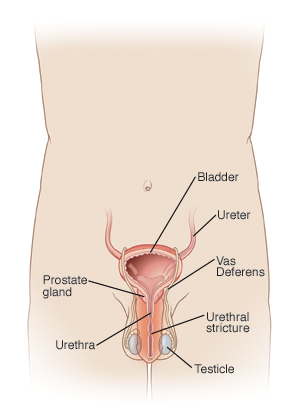Urethral Stricture

The urethra is the tube that carries urine out of the body. In a woman, the urethra's opening is in front of the vagina. In a man, it is at the tip of the penis. A narrowing or blockage of the urethra is called a urethral stricture. This is more common in men than in women.
Causes
A blockage of the urethra is often caused by scar tissue. This may be due to surgery, sexually transmitted infections, straddle injury, or long-term catheter use. The cause can also be unknown.
Other things that increase the risk of a blockage include:
-
Procedures that place a tube into the urethra (such as a catheter or cystoscope).
-
Benign prostatic hyperplasia (BPH).
-
An injury to the pelvic area (pelvic fractures).
-
Repeated urethritis.
-
Lichen sclerosis (a skin condition that usually affects the genitals).
Symptoms
The symptoms of urethral stricture include:
-
Slow urine flow or a urine stream that is split or that sprays.
-
Urine leakage or dribbling (incontinence).
-
Being unable to empty the bladder fully.
-
Pain when urinating.
-
Pain in the pelvis or lower belly.
-
A frequent urge to urinate.
-
Blood in the urine.
-
Pain in the lower abdomen and pelvic area.
Treatment
Treatments for a urethral stricture include:
-
Urethral dilatation. The urethra can be dilated using a dilator. Gradually increasing the size can stretch the tissue or widen the stricture. The area is most often numbed for this procedure. If your stricture is severe, or if dilation can't correct the condition, you may need surgery.
-
Urethrotomy. A cystoscope is sent along the urethra until the stricture is seen. A knife blade or laser at the end of the cystoscope is used to cut the stricture and create a gap. A catheter may be placed into the urethra to hold the gap open and let it heal.
-
Urethroplasty. For longer strictures, the blocked urethra may be removed and rebuilt. After surgery, you may need a short hospital stay and use a catheter for 2 or 3 weeks.
In acute cases when you cannot pass urine, a tube (catheter) may be put into your urethra to drain your bladder. This should ease the pain for a short time.
Urethral strictures can come back after surgery. You will need to follow up with a doctor who specializes in diseases of the urinary tract (urologist) to find the best treatment for your condition.
Home care
-
If you were given antibiotics, take them until they are used up, or until your doctor tells you to stop. Finish the antibiotics even if you feel better. This is to make sure your infection has cleared.
-
If a catheter was inserted, follow the instructions provided for catheter care.
Follow-up care
Follow up with your doctor, or as advised.
When to get medical advice
Contact your doctor right away if you have:
-
A fever of 100.4ºF (38ºC) or higher, or as directed by your doctor.
-
Bladder pain or fullness.
-
Belly pain or swelling.
-
Nausea or vomiting.
-
Back pain.
-
Weakness, dizziness, or fainting.
Online Medical Reviewer:
Marianne Fraser MSN RN
Online Medical Reviewer:
Raymond Kent Turley BSN MSN RN
Online Medical Reviewer:
Sravani Chintapalli Researcher
Date Last Reviewed:
6/1/2025
© 2000-2025 The StayWell Company, LLC. All rights reserved. This information is not intended as a substitute for professional medical care. Always follow your healthcare professional's instructions.